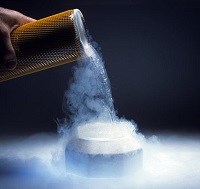Liquid Nitrogen in Human Oocyte Cryopreservation
- By : PureAire Monitoring Systems
- Posted on : October 10, 2013
- News Room
The word cryopreservation sounds like something from a science fiction movie. Maybe a man from the past was frozen in time, only to reawaken decades later, unharmed and unaware that he had been frozen at all. Though this scenario seems far-fetched, on a smaller scale, cryopreservation is a commonplace practice in the 21st century. While a grown man cannot be frozen and awoken, the building blocks of man are fair game.
Human oocyte cryopreservation, or egg freezing, is a way to freeze and preserve a woman’s eggs. At a later time, these eggs can be thawed and fertilized and used to impregnate the woman. There are many reasons a woman may be a candidate for this procedure. Some of these reasons are age, early menopause, and pre chemotherapy or radiation therapy, which may damage eggs left in the body. In any case, if a woman learns that she will be unable to produce healthy, viable eggs in her future, oocyte cryopreservation is a good option to ensure she has healthy eggs if she decides to try conceiving at a future time.
Semen and embryos can also be treated and cryopreserved in a similar way. These specimens can remain frozen for a long period of time. Embryos can be stored for up to 16 years, and semen as long as 22 years. This allows someone who is going through an illness or separation from a spouse to wait until a more viable time for implantation for conception.
Most people can easily understand the concept of freezing something to save for later, but the frozen eggs are not stored in your average icebox. Instead, liquid nitrogen freezes the eggs at −321 °F. This temperature is considered a deep freeze. With the addition of a cryoprotectant to deter ice crystals from forming, the specimens remain in the deep freeze until they are thawed for later use. Amazingly, over 500,000 live human births have been a result of such technologies.
There are over 400 facilities nationwide that can provide the oocyte cryopreservation procedure to women in need. On the patients end, the facilities seem like ordinary doctors offices, but the real magic takes place behind closed doors. The scientists and lab technicians use liquid nitrogen to conduct the deep-freezing, which can be very toxic if not used correctly. They rely on oxygen deficiency monitors to detect any lower than average levels of oxygen in the vicinity, which may indicate a nitrogen leak. For the whole sequence to go off without a hitch, the scientists need to remain confident in their safety throughout the process.
Pureaire Oxygen Monitoring Systems has created the perfect product to ensure such safety. Their O2 monitor is the best in the industry. The zirconium oxide sensor in the monitor lasts 10+ years with no maintenance or recalibration, making the product last longer than any other. This makes the monitor very cost effective, as it does not require additional purchases on a yearly basis. Also, the monitor’s ability to link to an alarm system, horn and strobe, and exhaust fan help warn people across a facility to evacuate an unsafe area.
There is no question that today’s scientific technologies are impressive, yet ever evolving. As a company, Pureaire Oxygen Monitoring Systems vows to support these growing technologies by keeping researchers safe and giving them the confidence to do their job creating families of the future.



